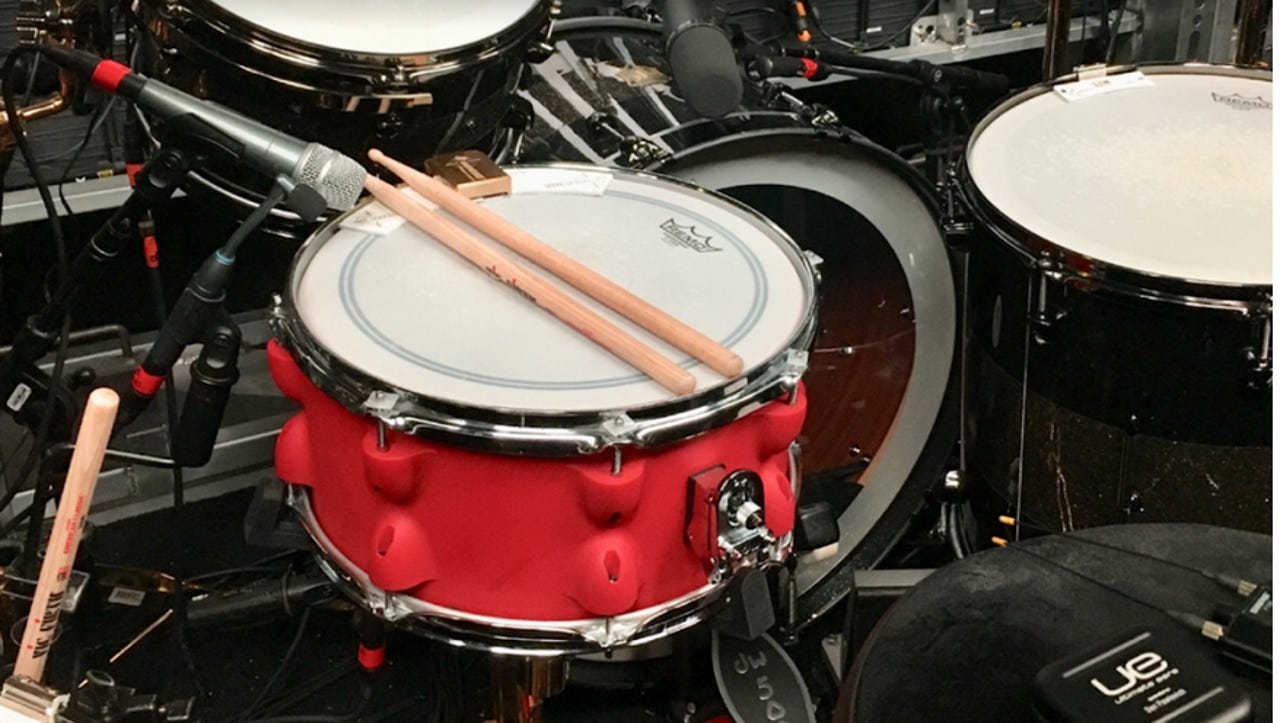Panic! At The Disco drummer bets on 3D printing to reinvent drum design

Dan Pawlovich, current drummer for Panic! At The Disco, highlights how 3D printing and prototyping is enabling tinkerers to try new ideas and change industries.
Pawlovich has been using Stratasys Direct to print the snare drums he uses on tour. Pawlovich has been interested in drum design from his teenage garage band days ever since he repainted a drum kit to customize it. ZDNet caught up with Pawlovich to talk 3D printing.
"Redesigning the drum is something that has been on my mind for countless years. The thing I wanted in my head was a wooden drum shell with lugs part of the shell," he explained. "The problem was that there wasn't a viable way to do it."
Also: Everything you need to know about 3D printing and its impact on your business
And then we watched a video online of someone 3D printing a working crescent wrench. "Luckily, I wasn't set on it being wood," said Pawlovich. "If there's a problem that seems impossible, it doesn't matter to me much because I always believe it will be solvable some day. I'll just work on something else and revisit it."
To get to where Pawlovich could actually use drums he designed it took about 6 to 7 years. Half that time was working with a designer on computer assisted designs and then the prototyping phase. very millimeter and measurement matters. The first Stratasys print was about 3 years ago. "There is no room for errors beyond 1mm," he said.
Here's a look at Pawlovich's approach and thought process with designing his own drums.
The fun, art, science
Pawlovich pursued drum design largely because it was fun. "Up to this point, all of it was fun. Designing this drum and spending a little bit of money for the design changes was fun. Getting prints right was almost all fun," he said.
The goal was to produce drums that sounded as good as normal ones and then lay the groundwork for customized sounds and unique musical approaches. On tour, Pawlovich needed a 3D printed drum that could handle temperature fluctuations, UV light and other elements and work with industry standard parts.
"Once it looked the way I wanted we had to hope it might sound good," he said. Pawlovich played the 3D printed drum in the green room backstage of the Panic! tour and knew he had something.

Why change the designs?
A traditional drum has a wooden or metal shell with metal rims and fasteners that attach the drum head onto the shell.
One drum shell has a clear note when tapped softly, but precision of the fundamental pitch is lost with metal parts attached to the shell.
Pawlovich was looking for something that resonated better. By incorporating metal lugs into the drum shell, the external hardware can't harm musical clarity.
The 3D printing technology used is similar to Laser Sintering or LS. LS builds from 3D CAD data via a CO2 laser that fuses powered thermoplastics layer by layer.
Pawlovich had to tinker with the design so it could use traditional tension rods, rims and drum heads that would be replaced. After various false starts, Stratasys Direct printed a prototype using Nylon 12GF material and a dyeing process called ColorTek to produce a red drum shell. AS a bonus, Nylon 12GF can handle temperature fluctuations, humidity and UV light.
Pawlovich has recorded experiments to compare 3D printed snare drums with a traditional version. The 3D printed one was as good if not better.
Is there a business here?
Pawlovich has patents on design and utility for his 3D printed drums and that process took about as long as the total design process. "I was new to the patent process too. It's more intense than the design process," he said.
Someday Pawlovich may have his own drum line, but for now the business side is tough to imagine. "Every time I think about the business side, I feel a weight on my shoulders," said Pawlovich. "I love the life I get to live as a musician right now."
Pawlovich also said he realizes that the business side takes time. When preparing for a Panic! tour, it takes anywhere from 6 to 8 months to get all the details lined up. You can't really start a business on tour.
Dan Pawlovich, drummer for Panic! At The Disco.
"I hope to see other drum manufacturers to eventually embrace the idea and show me a thing or two or 1,000. Right now we've only built a drum that shows it can live with traditional drums," said Pawlovich.
In the meantime, Pawlovich will tinker. "We've made a few design changes and slowly building up our files and options to push boundaries," he said.
Pawlovich has already designed a second iteration with a 5 1/2" deep snare drum. The shorter depth required a redesign for the lugs and shell diameter. The drum sounds more like a wood drum with its own town.
Related: